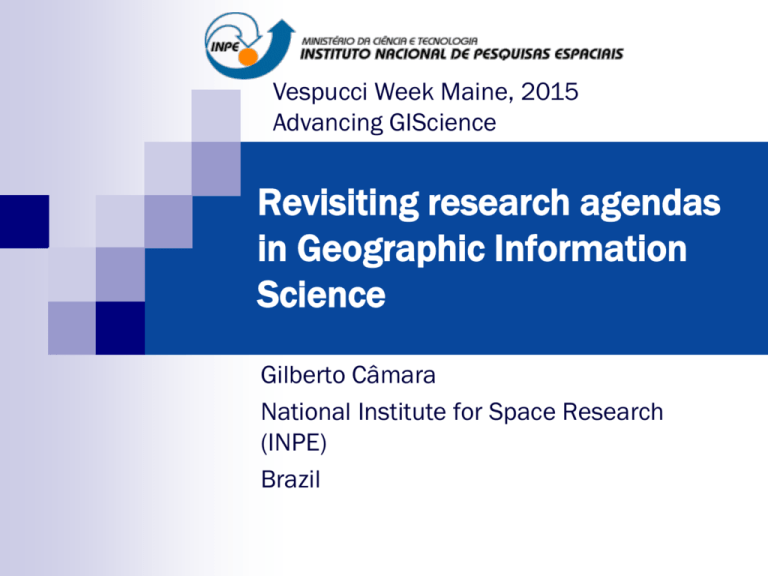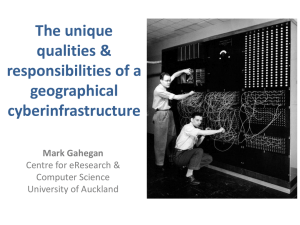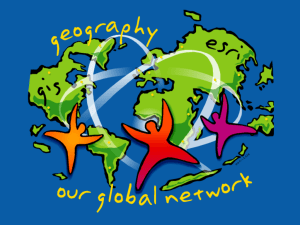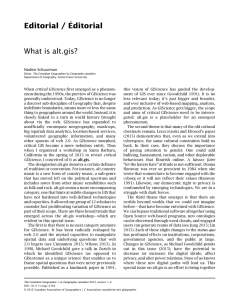Revisiting research agendas in Geographic Information - DPI
advertisement

Vespucci Week Maine, 2015 Advancing GIScience Revisiting research agendas in Geographic Information Science Gilberto Câmara National Institute for Space Research (INPE) Brazil NCGIA: original research initiatives Spatial Database Accuracy Languages of Spatial Relations Multiple Representations Use & value of geographical information Large spatial databases Spatial-decision support systems Visualisation of Spatial data Institutions sharing GIS Spatial-temporal reasoning Integration RS – GIS User interfaces for GIS GIS & Spatial Analysis GIS & Global Change Law, IP and Databases Collaborative decisionmaking Interoperating GIS Common-sense geographical worlds NCGIA today + Vespucci + Las Navas + …. Accuracy and uncertainty Spatial cognition Modelling and representation Spatial ontologies Semantics Interoperability Volunteered geographical information Digital Earth Big spatial data Smart cities and Science of cities CyberGIS Geovisualisation Land use science (…) All things spatial… Cognition Information Spatial Statistics Computing What’s misleading here? What’s central about spatial thinking? Spatial representations connect different expertises Makes the different conceptions explicit If (... ? ) then ... Desforestation? What’s central about spatial thinking? Spatial thinking does not replace disciplinary knowledge Territory (Geography) Money (Economy) Spatial Modelling (GIScience) Culture (Antropology) Does GIScience have a basic ambiguity? computational representations of geographical space or formal theories of geographical information? Path-dependence in GIScience Cartsen Kessler What’s in common btw GIScience and the QWERTY keyboard? Path-dependence in GIScience Weltanschauung GIScience deals with foundations Implementation and large-scale experimentations are left for engineers What are the risks of this world view? Pipeline model of Science Does this model apply to GIScience? The fascination with Artificial Intelligence and Cognitive Science Las Navas 1990: Cognitive and linguistics aspects of GIScience 1990: start of second “AI winter” The fascination with Artificial Intelligence and Cognitive Science ...but “Elephants don’t play chess” (R. Brooks) GIScience x Earth Sciences Earth Science explains how nature works by stating laws GIScience explains how society work by describing interactions Are there laws of GIScience? “Physics envy”: Popper “Science without laws” Clouds: statistical distributions Clocks, clouds or ants? Clocks: deterministic methods Ants: emerging behaviour Science: theory vs. experiments Representation (theories and laws) Mathematics Psychology Informatics Earth Sciences Cosmology Biosciences Experiments (reproducible practice) Science and applications feed each other Pasteur’s quadrant (Donald Stokes) The original plan for GIScience theory applications engineering The original plan for GIScience QSR WFS GEOS suite Multiple paths to Science ontologies Multiple paths to Science FOSS4GIS Multiple paths to Science spatial statistics The case of spatial statistics GeoDa R spatial High-citation rates for R packages A Pasteur’s quadrant view of GIScience ontologies ST reasoning QSR Spatial statistics FOSS4GIS use & value GIScience inside the big picture GIScience inside the big picture mobile devices social network Mobile devices, crowdsourcing, massive Earth observation sets: new technologies, new challenges sensors everywhere ubiquitous imagery Semantics of big data Records of interaction on human societies primary aim: communication Semantics of big data Observations of nature primary aim: description Semantics of big data Measurements of nature-society interaction primary aim: sustainability Current GIS is map-based Big data does not fit in the “map as set of layers” model network neighborhood location Core concepts of spatial information (Kuhn, IJGIS, 2012) field object event Core concepts as abstract data types Agent Coverage Set Network Time Series Event Trajectory 191610 (x) Geometry Field Object Big data requires new conceptual views 191610 (x) 575 (t) x 7 (λ) The Space-time Data Cube concept An Australian Geoscience Data Cube What is What is a geo-sensor? a geo-sensor? Field function: Position Value “Conceiving big spatiotemporal data as fields captures their nature better than the layeroriented (s,t) view”= v measure Egenhofer et al., GIScience 2014) s ⋲ S -(Câmara, set of locations in space t ⋲ T - is the set of times. v ⋲ V - set of values GIScience has a great future if we embrace a mix of theory and experiments We would we be better transforming our field into Geoinformatics







